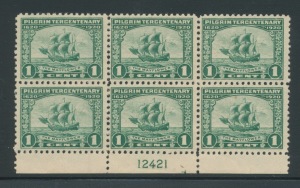One of the most idiosyncratic aspects of US philately is the collecting of plate blocks. Many countries have marginal plate numbers in the selvages of the sheets of their printed stamps. Most United States stamps that were printed before 1894 had plate numbers in the selvage, put there by the private printing contractor who printed the stamps so that they could keep track of things like plate wear or damage and remake the plates when they were needed. But plate blocks, as American collectors understand the term today, were really a phenomenon that began in the era of the US Bureau of Engraving and Printing.
The Bureau took over printing of United States postage stamps in 1894 and began numbering all plates that were used on US stamps in a consecutive manor, with no regard for what issue was being produced. Collectors in the 1890s had no idea that this change was taking place (if they did, they would have put away larger quantities of early marginal markings), and it was quite a few years before it was noticed, written about, and that these early marginal marking were collected. At first, there was quite an issue as to how those marginal numbers were to be saved. Strips of three lost out to plate blocks of 6, and, by about 1905, it was unusual to see strips collected and not blocks.
By 1920, the Post office had made the decision that sealed the popularity of plate blocks. Plate block collecting had become so popular and speculators so demanding that few people were buying full sheets. Collectors were going into post offices and buying just the plate blocks, leaving the balances of the sheets in the office, where they complicated postal accounting and didn’t leave any plates for later customers. The Post Office decided that only singles or full sheets could be purchased from a postal counter (except in the case of dollar value stamps where plate blocks could be sold if requested).
This decision had enormous impact on US philately. Far more stamps in the 1920-1950 period were sold to collectors than there was ever demand for. Many collectors planned to save the plate block and use the rest on mail, but most of these mint stamps got saved and exist even today in the philatelic biomass. This has meant tremendous quantities of most of the issues of the last 75 years are still in the philatelic market, making an increase in price for nearly any of these stamps nearly impossible and creating an impression that prices have languished (where the truth has been that prices for philatelic material issued in the era before collectors needed to save four or six have moved up quite nicely in price).
Plate block collecting is so pervasive among US philatelists that as postage values of stamps have increase, the Post Office has taken to issuing most stamps in sheets of twenty. After a period of multicolored stamps that had produced most plate blocks being different sizes (as each plate number represented are different color), American philatelists were sensitized to large block and willingly began to collect sheets of twenty of most new issues. These newer stamps have marginal markings and sometimes even plate numbers on them. But they are not plate blocks in the sense that earlier plate blocks were. Today’s stamps are produced on high speed presses where most of the time all of the colors are printed in one pass through the press. Further, the printing process is constantly photographed and analyzed by the printing press’s computers. Any problem with the plates can be determined without reference to the plate numbers and marginal makings printed at the same time as the stamps. Plate blocks today are largely a marketing ploy by the Postal Service, capitalizing on the tradition of US plates, but no longer having any reason to exist. Accordingly, they have been declining in collector popularity.


